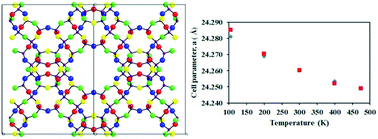Reprobing the mechanism of negative thermal expansion in siliceous faujasite†
Abstract
A combination of Rietveld refinement and pair distribution function analysis of total neutron scattering data are used to provide insight into the negative thermal expansion mechanism of siliceous faujasite. The negative thermal expansion mechanism of siliceous faujasite is attributed to the transverse vibrations of bridging oxygen atoms resulting in the coupled librations of the SiO4 tetrahedra. The constituent SiO4 tetrahedra are revealed to expand in size with temperature and they are also shown to undergo some distortion as temperature is increased. However, these distortions are not distinct enough in any geometric manner for the average behaviour of the SiO4 tetrahedra not to be considered as that of a rigid units. The work displays the benefits of using total scattering experiments to unveil the finer details of dynamic thermomechanical processes within crystalline materials.


 Please wait while we load your content...
Please wait while we load your content...